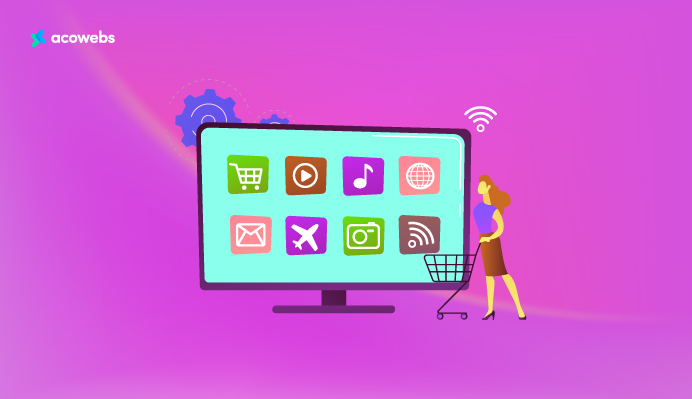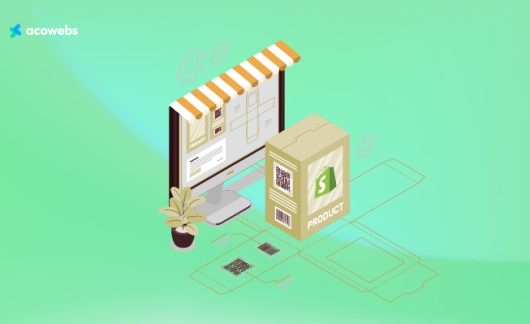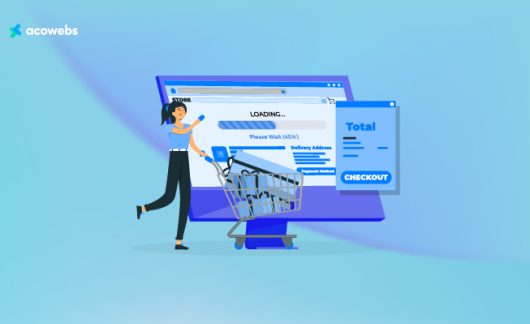eCommerce is no longer limited to conventional websites. Technology’s quick development has given companies new chances to engage with customers in creative ways.
eCommerce beyond websites has grown significantly since its inception, encompassing everything from smart TV buying to mobile app sales and even Internet of Things devices like wearables and smart speakers.
The increasing desire for ease of use, customized experiences, and smooth device integration is what is causing this change. Customers may now, for example, use voice commands on smart assistants to place direct product orders.
They are engaging in interactive shopping on their smart TVs while viewing their favorite programming. The retail industry is changing as a result of these new developments in online sales, which give companies previously unheard-of opportunities to interact with consumers.
Adopting these platforms is not only advantageous but also essential for maintaining competitiveness in a connected world as the limits of eCommerce continue to grow. Let’s look at these dynamic changes and their impact.
Selling Through Smart TVs
Smart TV – Image Source: Vision Plus
Millions of homes now have internet-connected televisions thanks to the sharp rise in the use of smart TVs. Businesses are now able to turn passive viewing into active shopping by simply integrating eCommerce features into smart TV interfaces.
For instance, with a few clicks on their remote control or a voice command, viewers can buy things that are featured in their favorite advertisements or shows.
Interactive Features Driving Engagement
There are several advantages to using smart TVs for eCommerce, with the paramount one being the ability to offer an immersive and engaging experience. Some of the features that characterize this modern technology include:
- Shoppable Content: Viewers can click on items within the interactive ad or video and purchase them immediately without disrupting their viewing experience.
- Voice-Activated Shopping: The addition of voice assistants such as Google Assistant or Alexa allows for voice-led shopping, thus immensely smoothing the process
- Customized Recommendations: Since viewing preferences and patterns can be analyzed for relevant product recommendations, it becomes easier to make tailored purchases.
- Customers can utilize AR technology to preview how items would look in their homes before making the purchase.
Benefits of Smart TV eCommerce
1. New Revenue Streams
Smart TV eCommerce gives companies a new channel for revenue diversification in the sale of goods and services. In contrast to the traditional eCommerce model, Smart TV platforms consolidate the shopping aspect directly into the viewing session.
This eliminates friction in the purchasing process, making it easier for businesses to capitalize on impulse buying. Because it lightens the load of pain points in the purchasing process, impulsive buys benefit firms. Subscription services, pay-per-view media, premium features—it’s also more income.
2. Enhanced Brand Visibility
With the help of smart TVs, marketers can easily include their logos in interactive content, such as games, apps, streaming services, and advertisements. In order to keep its logo and message in front of customers regularly, a business could sponsor a TV program or create an app with branded interfaces.
Compared to passive traditional advertisements, interactive content promotes user engagement and increases brand recall. Smart TVs’ immersive features and huge screens significantly enhance the effect of visual components, making an even greater impression on viewers.
Nike has created applications for smart TV platforms, such as the Nike Training Club. In addition to showcasing Nike’s trademark and emblem, these applications show off workouts conducted by athletes who the company sponsors.
Nike’s products are continuously presented to viewers who interact with the app, resulting in a smooth fusion of utility and brand awareness.
Nike Training Club Workouts on Netflix – Image Source: About Nike
3. Innovative Marketing Opportunities
Selling through smart TVs provides innovative marketing techniques by merging entertainment and commerce. Businesses, for example, can offer live events or interactive retail programs where viewers can make real-time purchases. Interactive advertisements and gamified material, such as quizzes with prizes or discounts for participation, increase interest.
Furthermore, contextual marketing (such as recommending products based on the sort of content being watched) enables firms to provide highly relevant and tailored experiences that capture attention more successfully than traditional techniques.
4. Data-Driven Insights
Smart TVs’ powerful analytics capabilities give businesses useful information about consumer behavior, such as viewing patterns, app usage, and purchasing preferences. This information can be utilized to improve product offers, optimize ad placements, and create tailored marketing strategies.
For example, if analytics show that a given show is popular with a certain demographic, firms can tailor their promotions accordingly. Over time, this allows for more informed decision-making, efficient resource allocation, and a higher return on investment for marketing initiatives.
5. Stronger Customer Engagement
Smart TVs’ interactive features promote closer interactions between marketers and consumers. Consumers, for example, can engage in polls, submit reviews, or access exclusive material directly from their smart TVs, increasing their sense of connection.
This two-way communication increases customer loyalty by making them feel valued. Furthermore, features such as personalized suggestions based on watching history or customized content improve the user experience.
This increases the likelihood of customers engaging with the business and remaining loyal over time.
Selling Through Apps
With smartphones being the primary means of accessing Internet services, mobile applications offer a streamlined, user-friendly platform that boosts customer engagement, sales, and brand loyalty.
Their accessibility, tailored experiences, and improved functionality make them essential to modern Internet selling techniques.
Here are the key reasons why mobile apps are essential for online selling:
1. Enhanced User Experience
Mobile apps are designed to offer a superior user experience compared to mobile websites. They are faster, more responsive, and provide a seamless interface tailored specifically for mobile users.
Features like simplified navigation, quick load times, and easy checkout processes reduce friction, encouraging users to stay longer and complete their purchases.
The Amazon mobile app provides a better purchasing experience than the mobile website. It has individualized product recommendations, rapid product searches, and a simple interface.
Users may save payment information for one-click purchases, follow orders in real time, and use the app’s barcode scanner to compare prices in actual locations.
These improvements make the software faster, more convenient, and more entertaining for users, resulting in increased conversion rates and customer satisfaction.
Amazon Shopping App – Image Source: CNN
2. Personalization
Selling through apps involves leveraging data-driven insights to create highly tailored shopping experiences that are more engaging and successful. Apps that use machine learning and user analytics can evaluate surfing history, purchasing behavior, and user preferences to provide tailored recommendations.
An app may recommend comparable products, highlight items on a user’s wishlist, or provide unique bargains based on previous interactions. This level of customization not only makes users feel understood and cherished but also improves usability by giving relevant options.
As a result, tailored experiences increase consumer loyalty, boost repeat purchases, and improve user satisfaction and retention.
3. Push Notifications
Push notifications are a key feature of mobile apps that allows businesses to communicate with customers in real time. These alerts send timely updates on new product arrivals, unique discounts, flash promotions, and abandoned cart reminders right to the user’s device.
Push notifications, unlike emails or SMS, are more immediate and less obtrusive, making them extremely successful at attracting attention. They keep the brand at the forefront of their minds by sending tailored and relevant messages, prompting users to take action, such as revisiting the app or making a purchase.
This direct communication strengthens customer relationships and increases engagement and conversion rates.
Push Notifications – Image Source: Playbook
4. Offline Accessibility
Mobile apps have the upper hand when it comes to offline capabilities. Installed apps allow for a stored view of the data previously invoked by the app so that the users can continue to utilize certain functions without any Internet connection.
For instance, users can browse the wish lists, navigate product details, and revert to any item saved earlier. This ensures fluidity and convenience, the very quality to be desired in areas of little or no Internet connectivity.
Through the support of offline functionality, apps increase reliability and user satisfaction, providing an attractive alternative for users who require constant access to important information.
This feature not only enhances the user experience but also elevates engagement as users can interact with the app at any time, regardless of the connectivity.
Features to Enhance In-App Shopping Experiences
To maximize the efficacy of retail apps, add functions to features that enhance the user’s engagement and satisfy the needs of modern customers. Here are some important features that support in-app shopping.
- Intuitive User Interface(UI): Clean and nice-looking designs let users walk through the application region without any hesitation. The simple layouts, clear categorization, and friendly searches ensure that great shopping pleasure is given to users.
- AI-Powered Suggestions: Adding artificial intelligence to the app enables data-driven, real-time product recommendations. For instance, the highly engaging Amazon mobile app offers tailored suggestions based on past searches and purchases.
- Multiple Payment Methods: Options for payments, including credit cards, digital wallets, and BNPL (buy now, pay later), allow users a certain level of convenience. Assuring a secure gateway for payments also helps build trust and confidence concerning the platform’s use.
- In-App Chat Support: Having real-time assistance through chatbots or live agents in-app allows instant resolving of queries. This minimizes cart abandonment and improves the overall shopping experience.
- Social Sharing and Reviews: Users can share products on social media or read reviews right within the app to enable the establishment of social proof and word-of-mouth promotion.
- Loyalty and Reward Programs: Integration of loyalty points schemes, referral bonuses, or tiered reward programs tends to boost repeat purchases by the users. Engaging gamified elements can also play a big role, like earning badges or unlocking perks or rewards.
- Real-Time Order Tracking: Sharing information and live updates regarding the order and delivery status reassures customers that they have been made aware of what they have purchased.
- Voice Searches and Commands: With the rising popularity of voice technology, voice searching powered by the app could be integrated to allow ease of use in quick searching with hands-free mode.
Selling Through IoT Devices
Smart speakers, wearable, and connected appliances of IoT devices are integrating and automating eCommerce functionality with utmost style. These devices are reshaping customer experiences and are driving the future of shopping.
Smart home devices, such as voice-activated assistants Amazon Alexa and Google Home, are becoming central to the modern eCommerce experience.
Such devices empower users to reorder essentials, check product availability, or add items to their shopping lists with simple voice commands.
How does IoT revolutionize customer convenience?
1. Automation
The major perks of selling through IoT devices are its automation capabilities. Smart appliances can monitor usage patterns and act on the unearthed insights. For example, a smart fridge will know when milk or vegetables run down and deliver reminders or even place automatic orders.
This level of automation will ease the burden of decision-making and ensure that customers never run out of important items. So, retailers get the additional benefit of enjoying consistent demand and improved customer retention.
2. Personalized Interactions
IoT devices are wonderful for providing personalized experiences through the acquisition of behavioral preferences and purchase habit data. They analyze behaviors, preferences, and purchasing history to recommend products more aligned with their needs.
For example, a smart speaker can suggest recipe ideas based on items currently in the user’s refrigerator and will recommend purchasing any missing ingredients.
Besides enhancing the shopping experience, personalized interactions help build customer loyalty because the user feels recognized and appreciated.
3. Multi-Device Integration
A hallmark of the IoT ecosystem is the seamless integrated functioning of many devices. From smart speakers to smart appliances, all these devices work seamlessly to ensure a clearer shopping experience.
A user can create their shopping list on their smart speaker, receive a notification about a relevant discount on their watch, and turn to their cell phone to complete the purchase. Such integration ensures ease of use and seamless transitions across devices, allowing for a much happier shopping experience.
Challenges in eCommerce Beyond Websites:
1. Technological Complexity
The integration of platforms such as smart TVs, mobile apps, and IoT devices into eCommerce presents considerable technological challenges.
The fragmented ecosystem, spanning a wide variety of devices, brands, operating systems, and protocols (e.g., Zigbee, Z-Wave, Wi-Fi), requires businesses to build multiple compatible solutions.
Ensuring smooth interoperability among devices requires an investment of sufficient funds behind robust APIs and backend systems, such as syncing the shopping list and setting it against a backdrop of a smart speaker, smartwatch, and smartphone.
2. Data Privacy and Security Risks
IoT devices that collect sensitive data-including purchase histories and voice commands-present heightened risks of data breach. A single vulnerability can cripple an entire network of devices while individual regions have diverging data privacy laws (e.g., GDPR, CCPA).
This can make compliance an uphill task for businesses working with data across jurisdictions. Other than that, IoT devices have very poor security protocols, making them more vulnerable to hacking that may compromise sensitive consumer data.
3. User Adoption and Trust
Consumer adoption of eCommerce on platforms like smart TVs and IoT devices remains limited, partly due to a lack of awareness. Many consumers also express skepticism about automated systems (e.g., smart refrigerators reordering items) due to concerns about accuracy and control.
Building trust is crucial, with users needing clear benefits and reassurances about privacy, especially when devices track personal data like viewing habits or daily routines.
4. Operational and Financial Barriers
The development, testing, and maintenance of eCommerce apps for various platforms is resource-intensive, with businesses needing to address compatibility issues and ensure continuous updates.
Scaling IoT-based eCommerce solutions is more complex than traditional web platforms, requiring substantial infrastructure to handle large user requests. Additionally, IoT-enabled purchases can result in unintended orders, complicating returns and refund management.
5. Ethical and Legal Issues
Emerging eCommerce technologies raise concerns over manipulative marketing practices, as personalized recommendations and contextual ads may be perceived as exploitative.
Companies must balance targeted marketing with ethical practices to avoid backlash. Furthermore, the legal landscape is slow to adapt, leaving businesses uncertain about regulations, particularly regarding voice-activated purchases without explicit user consent.
6. Accessibility and Inclusivity
The digital divide remains a significant issue, as not all consumers have access to smart devices or high-speed internet, alienating low-income or rural populations.
Additionally, IoT devices and smart TVs often cater to tech-savvy users, potentially leaving behind older or less tech-literate individuals. In order to avoid exclusion, businesses must simplify interfaces and ensure broader accessibility.
Conclusion
The evolution of eCommerce beyond websites into platforms like smart TVs, mobile apps, and IoT devices signifies a transformative shift in how businesses engage with consumers.
The new technology provides for newer ways of shopping, personalized experiences, and channels for marketing. From smart TVs displaying shoppable ads to providing AI recommendations on an app and enabling voice purchases via an IoT device, the possibilities are expanding quickly and endlessly.
However, such growth brings with it challenges like complexities with technology, data security risks, and issues of accessibility and sustainability.
Such issues can be dealt with only when businesses have funds to invest in upgrading their infrastructure, ensuring privacy for the various users, and incorporating ethics and inclusivity in modern practices.
As eCommerce continues to redefine itself, companies on the leading edge of such trends will no longer simply engage their customers better but also seal a competitive edge on a digital marketplace where everything is connected.
Acowebs are the developer of the WordPress offload media plugin which allows you to offload your media to cloud storage such as Amazon s3, Cloudflare r3, Google Cloud, Digital Ocean and more. Media cloud wordpress also helps to sync your media to cloud storage in 1 click and woocommerce email customizer using which you can easily build and customize WooCommerce emails with a drag-and-drop user interface.












 Login
Login
 Cart
Cart







